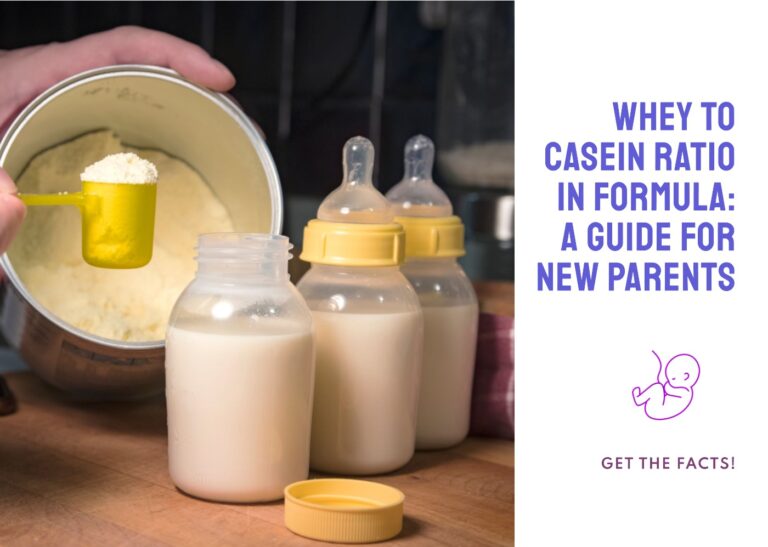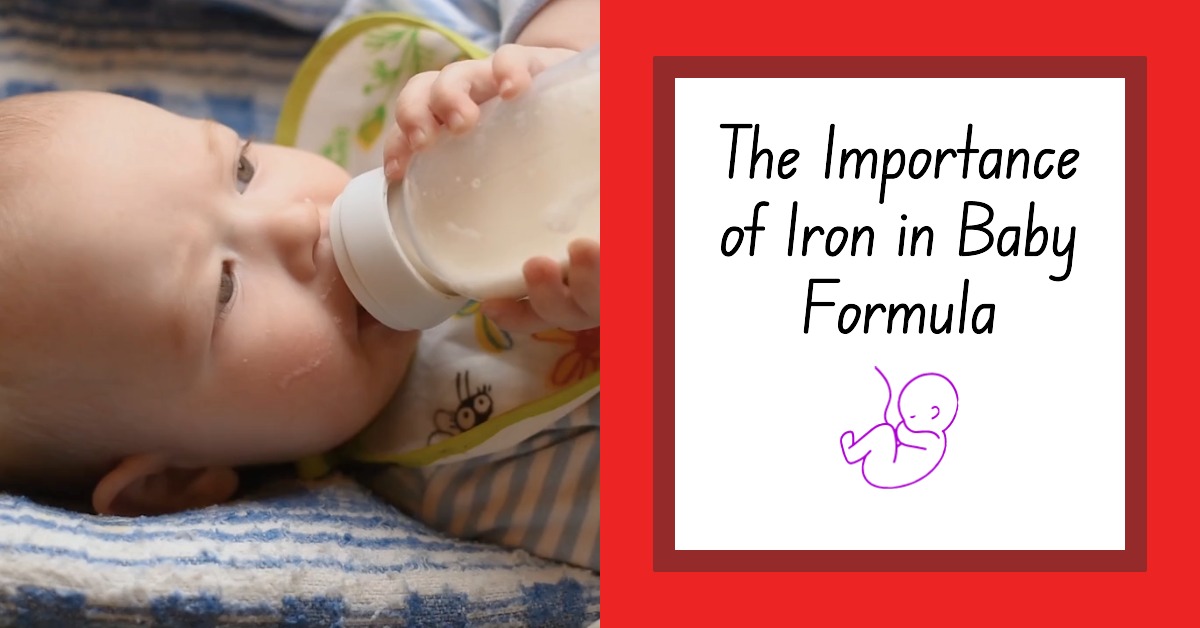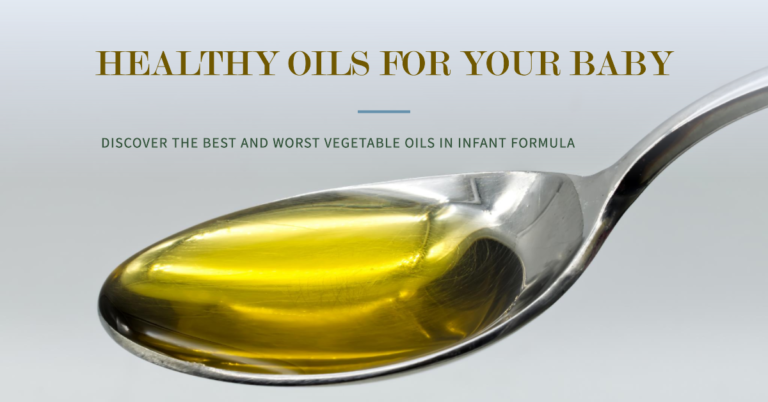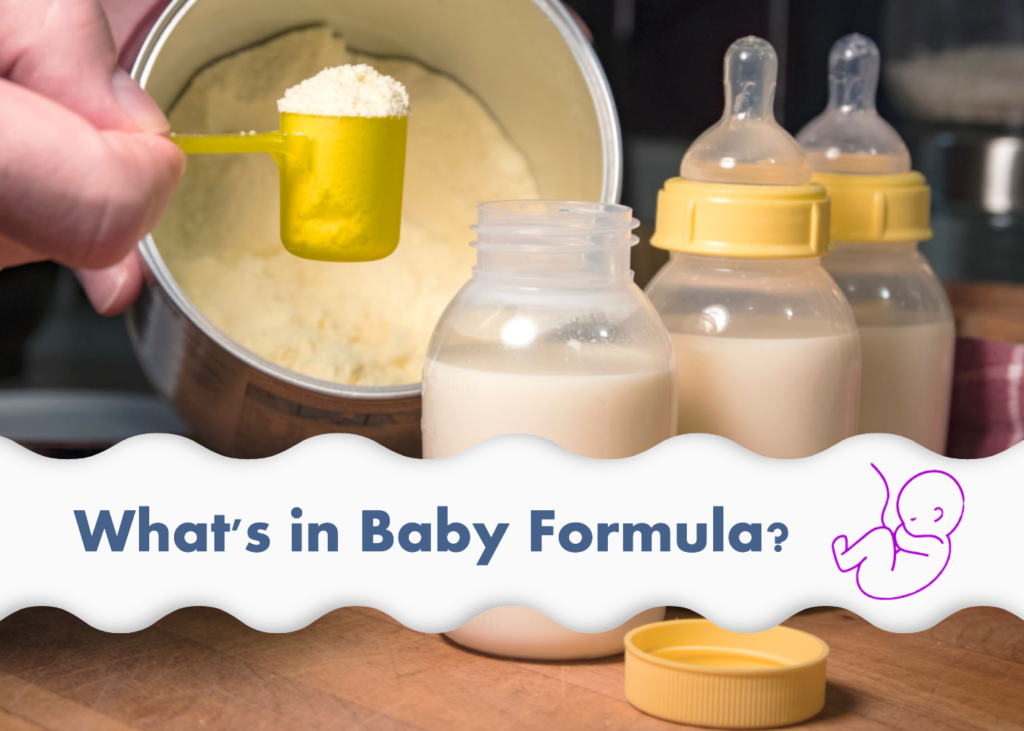
Key Ingredients in Baby Formula
Essential Ingredients
Most infant formulas should have these, except specialty formulas with a special composition for special babies.
| Ingredient | Name on Label |
|---|---|
| Protein | Whey, casein |
| Carbohydrates | Lactose |
| Fat | Sunflower oil, coconut oil, high oleic oils, and palm oil (palm is considered safe. Read more here) |
| Vitamins and Minerals | Vitamin A, Vitamin D, Iron, Calcium, Zinc |
| DHA | Docosahexaenoic acid |
| ARA | Arachidonic acid *Read: DHA and ARA in Baby Formula |
Optional Ingredients
Not all baby formulas will have these, but they may benefit some babies.
*Read: Prebiotics and probiotics in infant formula
| Ingredient | Name on Label |
|---|---|
| Probiotics | Bifidobacterium lactis, Lactobacillus rhamnosus |
| Prebiotics | Galacto-oligosaccharides, fructo-oligosaccharides |
| Additional Fibers | Polydextrose, Inulin |
| Nucleotides | Cytidine 5′-monophosphate, adenosine 5′-monophosphate |
Controversial and Special Ingredients
Scan the labels for these ingredients.
Only corn syrup solids and maltodextrin are useful when lactose is not present or in less quantity for lactose intolerant babies.
*Read: Corn Syrup in baby formula | Maltodextrin in baby formula | European vs American Baby Formula
| Ingredient | Name on Label |
|---|---|
| Artificial Sweeteners | Sucralose, aspartame, acesulfame potassium |
| Added Sugars | Corn syrup solids, sucrose, glucose syrup solids |
| Partially Hydrogenated Oils | Partially hydrogenated soybean oil, partially hydrogenated coconut oil |
| Certain Thickening Agents | Carageenan, maltodextrin |
| Preservatives | Sodium benzoate, potassium sorbate |
| Synthetic Nutrients | Lutein, Lycopene, Nucleotides, Taurine |
This article aims to provide new parents with all the information they need about what’s in baby formula: its ingredients and their benefits and dangers so that they can make informed decisions when choosing a formula for their baby.
Let’s get after it!
Our short answer and experience
We believe understanding the infant formula ingredients you will give your baby is essential.
We don’t mean knowing all the chemical nomenclature but the basics, the important ingredients, those that are not so important, and those that should not be there.
The purity and quality of the ingredients is the most important factor when choosing a formula, so make sure that whatever you choose suits your baby’s needs and is as pure as possible.
We advise you to read the entire article for a broader context and visit our infant formula section, where you can find dozens of formula comparisons and lists of the best ones.
What does the ingredient label of a pure, high-quality formula look like?
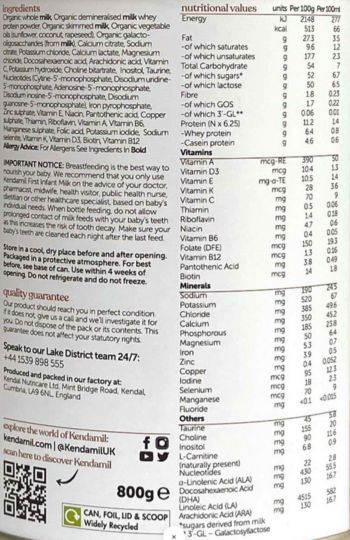
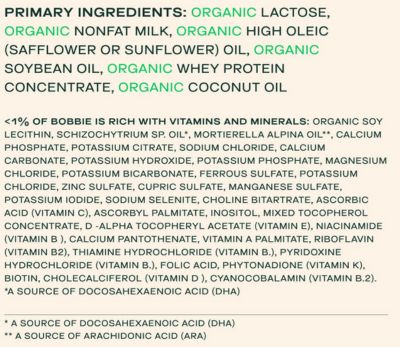
What Is Baby Formula?
Baby formula is a nutritional substitute for breast milk that provides essential nutrients to infants
Baby formula has a history dating back to the 19th century, evolving from homemade mixes to modern, nutrient-rich alternatives that support infant growth, brain development, and immune system function, addressing dietary considerations.
What is its history?
The history of baby formula dates back to the 19th century, with roots in wet nursing and bottle feeding.
One key milestone was in 1865, when German chemist Justus von Liebig created the first commercial infant formula based on cow’s milk.
Over time, advances were made regarding the composition and safety of baby formulas.
Around the 1930s or early 1940s, most formulas fed to infants in the United States consisted mainly of evaporated milk or fresh cow’s milk mixed with other ingredients at home.
Baby formula has come a long way throughout its evolution, from homemade concoctions to carefully balanced breastmilk alternatives that meet nutritional standards for infant growth.
Nowadays, modern formulas are rich in essential nutrients that support various aspects of healthy infancy, such as brain development, immune system function, and more, while catering to special dietary considerations like allergies or lactose intolerance.
Why Ingredients Matter in Baby Formula
Formulas replicate breast milk and provide balanced nutrients for brain, bone, muscle, and immune system development.
Special formulas cater to specific needs like lactose intolerance or allergies.
Understanding the ingredients in baby formula is crucial for new parents, as it directly impacts a baby’s growth and development.
Rapid changes mark the first few months of an infant’s life, and adequate nutrition is essential to support these changes.
A well-rounded diet provides all the necessary nutrients for healthy brain development, strong bones and muscles, and a robust immune system.
Commercially available baby formulas are designed to replicate the nutritional composition of breast milk as closely as possible.
A high-quality formula contains carefully balanced proteins, fats, carbohydrates, essential vitamins, and minerals that cater to an infant’s specific needs during this critical developmental stage.
Moreover, knowing about different types of formulas – such as lactose-free options for infants with lactose intolerance or hypoallergenic formulas for those with allergies – can be invaluable in ensuring your child gets off on the right foot health-wise.
What are the basic ingredients in baby formula?
Baby formula contains six basic components: proteins from cow’s or goats’ milk or soy, carbohydrates from lactose or other sources, essential fatty acids like DHA and ARA, vitamins and minerals such as iron and calcium, prebiotics and probiotics for gut health, and nucleotides for immune system support.
Proteins: Sources and types
Protein is an essential ingredient in baby formula as it plays a significant role in the growth and development of infants.
Understanding the sources and types of proteins in baby formulas can help you make informed choices for your little one.
Source of Protein in Baby Formula
| Sources of Protein | Type of Protein |
|---|---|
| Cow’s Milk | Whey and Casein |
| Goat’s Milk | Whey and Casein |
| Organic Milk | Whey and Casein |
| Soy | Soy Protein |
| Whey Protein Concentrate | Whey Protein |
*Read: Whey-To-Casein Ratio in Formula
Digestibility and Suitability of Proteins
| Type of Protein | Digestibility | Suitable For |
|---|---|---|
| Whey | Easily Digestible | Most Infants |
| Casein | Slower to Digest | Most Infants |
| Soy Protein | Variable | Infants with Cow’s Milk Allergies or Lactose Intolerance |
Descriptions of Protein Sources
| Sources of Protein | Description |
|---|---|
| Cow’s Milk | Most baby formulas use purified cow’s milk whey and casein as their primary protein source. |
| Goat’s Milk | Goat’s milk-based formulas are an alternative to cow’s milk and contain similar protein profiles. Some parents prefer goat’s milk formula due to being easier to digest for some babies. *Read: Goat vs Cow milk formulas |
| Organic Milk | Organic milk protein formulas use milk from cows raised without antibiotics or growth hormones, and their feed is grown without pesticides or chemical fertilizers. *Read: Benefits of Organic Formulas |
| Soy | Soy-based formulas use soy protein as an alternative to cow’s milk protein, making them suitable for infants with cow’s milk allergies or lactose intolerance. However, some infants may also be allergic to soy protein. |
| Whey Protein Concentrate | Whey protein concentrate is a form derived from cow’s milk that undergoes a filtration process to remove most non-protein components, such as lactose and fat. |
Carbohydrates: Sources and types
Carbohydrates are essential for providing energy to your baby, and several types and sources are found in baby formula.
Type and Source of Carbohydrates in Baby Formula
| Carbohydrate Type | Sources |
|---|---|
| Lactose | Cow’s and Goat’s Milk |
| Maltodextrin | Corn, Rice, or Potatoes |
| Corn Syrup Solids | Hydrolyzed Corn Starch |
| Sucrose | Various Sources |
| Soy-based Carbohydrates | Corn Syrup or Sucrose |
Descriptions and Usage of Carbohydrates
| Carbohydrate Type | Description and Usage |
|---|---|
| Lactose | The most common carbohydrate in baby formula. Preferred because it is closest to the carbohydrates found in breast milk. |
| Maltodextrin | Derived from corn, rice, or potatoes. Used as a thickening agent and carbohydrate source in some baby formulas. |
| Corn Syrup Solids | Made from hydrolyzed corn starch, contain moderate to high levels of glucose. Used as a carbohydrate source in some baby formulas, especially for those that are lactose-free. |
| Sucrose | Sometimes used as a carbohydrate source in baby formula, though it’s less common as it may increase the risk of dental issues and obesity. |
| Soy-based Carbohydrates | Soy formulas use carbohydrates like corn syrup or sucrose instead of lactose because they are lactose-free and suitable for infants with lactose intolerance or milk protein allergies. |
Fats: Essential fatty acids and their importance
One of the key ingredients in baby formula is fat, essential for an infant’s development and growth.
Fats consist of smaller components known as fatty acids, some vital for brain and nervous system development.
Type and Source of Fats and Oils in Baby Formula
| Type of Fat or Oil | Sources |
|---|---|
| Palm Oil | Palm Tree |
| Soy Oil | Soybeans |
| Coconut Oil | Coconut Palm |
| Sunflower Oil | Sunflower Seeds |
| High Oleic Sunflower Oil | Sunflower Seeds |
| Safflower Oil | Safflower Seeds |
| Fish Oil | Fish |
| Algal Oil | Microalgae |
Descriptions and Usage of Fats and Oils
| Type of Fat or Oil | Description and Usage |
|---|---|
| Palm Oil | A source of saturated fat used in some formulas. However, there’s some controversy around its potential impact on calcium and fat absorption. |
| Soy Oil | A source of polyunsaturated fats, typically combined with other oils in a blend, to achieve the desired fatty acid profile. |
| Coconut Oil | A source of saturated fat that provides medium-chain triglycerides, beneficial for quick energy and brain function. |
| Sunflower Oil | A source of polyunsaturated fats, usually high in linoleic acid, an essential fatty acid. |
| High Oleic Sunflower Oil | Similar to sunflower oil but higher in monounsaturated fats and lower in polyunsaturated fats, providing a closer match to the fatty acids in breast milk. |
| Safflower Oil | Often high in linoleic acid and thus used for its polyunsaturated fats. |
| Fish Oil | Provides DHA and EPA, omega-3 fatty acids important for brain and eye development. |
| Algal Oil | A plant-based source of DHA, suitable for vegetarian formulas. |
Vitamins & Minerals
Vitamins and minerals play a crucial role in supporting the healthy growth and development of your baby. Baby formula provides essential vitamins and minerals to ensure that your infant receives adequate nutrition. Below is a table listing these essential nutrients and their benefits for your baby.
| Vitamin/Mineral | Benefits |
|---|---|
| Vitamin A | Supports healthy vision, immune system, and cell growth. |
| Vitamin D | Helps in calcium absorption, bone growth, and immune system function. |
| Vitamin E | Acts as an antioxidant and supports immune system function. |
| Vitamin K | Assists in blood clotting and bone health. |
| B Vitamins | Contribute to healthy metabolism, energy production, and brain function. |
| Iron | Essential for the production of hemoglobin and overall growth and development. |
| Calcium | Crucial for developing strong bones and teeth and nerve and muscle function. |
| Human Milk Oligosaccharides (HMOs) | Beneficial for the absorption of minerals like magnesium, calcium, zinc, and iron |
Special Ingredients in Baby Formula
Special ingredients in baby formula include prebiotics and probiotics for digestive health, and DHA and ARA for brain and eye development.
Baby formulas may include prebiotics and probiotics for a healthy digestive system, DHA and ARA for brain and visual development, lactoferrin for immune support, and nucleotides for cell growth.
These ingredients offer optimal nutritional benefits and good growth rates for infants.
Prebiotics and Probiotics
Prebiotics and probiotics are types of beneficial bacteria found in many baby formulas. They’re designed to support a healthy digestive system and robust immune function in infants.
Prebiotics are a type of carbohydrate that act as food for probiotic bacteria, encouraging them to flourish in the gut. ?
Probiotics introduce new beneficial bacterial strains to the gut microbiome, helping restore balance and promote healthy digestion.
Many leading infant formula brands include both pre- and probiotics in their formulations today. *Read: Best formulas with prebiotics and probiotics
DHA and ARA
DHA (Docosahexaenoic Acid) and ARA (Arachidonic Acid) have become increasingly essential to most infant formulas in the market today. ?
These are Omega-3 and Omega-6 fatty acids naturally found in breast milk.
DHA and ARA help support an infant’s brain ? development and visual functioning.
Studies suggest that infants given formula supplemented with DHA and ARA exhibit cognitive abilities similar to those exclusively breastfed for six months or longer. These nutrients can be sourced from fish oil ? or algae ?, making them vegan-friendly options in some baby formulas.
Lactoferrin and Nucleotides
Lactoferrin and nucleotides are two special ingredients that may be found in some baby formulas.
Lactoferrin is a protein that naturally occurs in breast milk and helps fight pathogens by binding to the iron they need to grow. It also supports digestive health, a crucial aspect for infants as their immune system develops.
Nucleotides, on the other hand, play an essential role in supporting cell growth, repair, and reproduction.
While not all infant formulas contain lactoferrin or nucleotides, those that do often have specific blends of prebiotics and probiotics like PDX and GOS to deliver optimal nutritional benefits for babies.
Clinical studies suggest that routine infant formula with these added ingredients can provide good growth rates while being well-tolerated by most infants.
Special Dietary Considerations in Baby Formulas
Specialized baby formulas are available for infants with lactose intolerance, allergies, and preterm or low birth weight babies.
Learn more about these options and how to choose the right formula for your baby’s unique needs.
Specialized lactose-free formulas and soy-based formulas are available for babies with lactose intolerance.
Hydrolyzed formulas are recommended for infants with allergies to cow’s milk proteins.
Preterm or low birth weight babies may need specialized formulas with higher calorie content and specific protein types.
Formulas for lactose intolerance
If your baby has trouble digesting lactose — the sugar found in milk — specialized formulas are available to meet their nutritional needs. These formulas are designed to be gentle on sensitive stomachs and provide all the necessary nutrients.
Lactose-free formulas: Cow’s milk-based formulas labeled as lactose-free can be beneficial.
Soy-based formulas: These can be a helpful alternative for lactose-intolerant infants.
It’s worth noting that lactose-free formulas also come in ‘sensitive’ varieties. However, not all ‘sensitive’ formulas are lactose-reduced. Always check labels ?️ or consult with a healthcare provider before switching.
Additionally, many babies with lactose intolerance may still be able to tolerate small amounts of lactose in their diets without issue.
Hypoallergenic formulas for infants with allergies
Babies can be born with allergies, even to the proteins in traditional baby formula made from cow’s milk. ? For infants who are allergic or intolerant to these ingredients, hydrolyzed formulas are available.
These formulas contain partially hydrolyzed proteins broken down into smaller parts and can be easier for babies with sensitive digestive systems to tolerate.
In some cases, special hypoallergenic options may also provide pre-digested proteins, making it easier for babies with a cow’s milk allergy to digest without fear of triggering an allergic reaction.
Formulas for preterm or low birth weight babies
Infants born preterm or with low birth weight often require specialized formulas to meet their nutritional needs. ? These babies are at higher risk for growth and development issues, so choosing the right formula is crucial.
Pediatricians may recommend formulas with higher calorie content or specific protein types to support their growth. ?
Understanding Labels on Baby Formula

Look for the Type of Formula: The front of the canister will generally tell you what kind of formula it is. For instance, it could be a “Milk-based” or “Soy-based” formula. Some might also indicate whether it’s designed for certain needs, like “Lactose-Free,” “Hypoallergenic,” or “For Preterm Babies.”
Check for the Primary Ingredients: Typically listed in order of quantity, the main ingredients are usually some source of protein, carbohydrates, and fats. These are the ones we discussed earlier in this guide.
Find the Vitamins, Minerals, and Additives: Look for added nutrients like DHA, ARA, prebiotics, and probiotics, as well as essential vitamins and minerals.
Read the Allergen Information: Formula labels should clearly list any allergens. Common allergens include milk, soy, and sometimes fish (from fish oils).
Examine the Preparation Instructions: Most formulas come in either ready-to-use, concentrated, or powdered forms, each requiring a different preparation method. Follow the instructions carefully to ensure you’re providing the correct concentration.
Use-by or Expiration Date: It’s important to ensure the formula is still within its freshness date for maximum nutritional benefits and safety.
What are the FDA’s nutrient requirements for infant formula?
The FDA specifies the following nutrient requirements for infant formula per 100 kilocalories of the formula as prepared for consumption:
- Protein: 1.8 – 4.5 grams
- Fat: 3.3 – 6.0 grams
- Percent calories from fat: 30 – 54%
- Linoleic acid: 300 milligrams
- Percent calories from linoleic acid: 2.7%
Vitamins:
- Vitamin A: 250 – 750 International Units
- Vitamin D: 40 – 100 International Units
- Vitamin E: At least 0.7 International Units
- Vitamin K: 4 micrograms
- Thiamine (Vitamin B1): At least 0.40 micrograms
- Riboflavin (Vitamin B2): At least 0.60 micrograms
- Vitamin B6: At least 0.35 micrograms
- Vitamin B12: At least 0.15 micrograms
- Niacin: At least 250 micrograms
- Folic acid (Folacin): At least 4 micrograms
- Pantothenic acid: At least 300 micrograms
- Biotin: At least 1.5 micrograms (required only for non-milk-based infant formulas)
- Vitamin C (Ascorbic acid): 8 milligrams
- Choline: At least 7 milligrams (required only for non-milk-based infant formulas)
- Inositol: At least 4 milligrams (required only for non-milk-based infant formulas)
Minerals:
- Calcium: At least 60 milligrams
- Phosphorus: At least 30 milligrams
- Magnesium: At least 6 milligrams
- Iron: 0.15 – 3.0 milligrams
- Zinc: At least 0.5 milligrams
- Manganese: At least 5 micrograms
- Copper: At least 60 micrograms
- Iodine: 5 – 75 micrograms
- Selenium: 2 – 7 micrograms
- Sodium: 20 – 60 milligrams
- Potassium: 80 – 200 milligrams
- Chloride: 55 – 150 milligrams
Conclusion
Thank you very much for making it to the end.
We hope you found the post informative and that you come away from it with valuable information you will surely use to choose the best formula for your baby.
We’d love to hear your experiences, questions, and insights in the comments.
See you soon!
We’re Maria and Alberto, a married couple and educators who are nutrition enthusiasts. Even before we had kids, we were already crazy about nutrition.
We’d read scientific articles, watch videos from nutritionists, and spend hours listening to nutrition podcasts.
Today, we continue doing this, but in a different way, as we’ve learned to sift through the noise and trends. Nutrition, like any other field of knowledge, the more you read and learn, the more you develop a comprehensive understanding of reality, and that’s what has happened to us.
Before having our first child, we focused on learning everything we could about child nutrition, using the same techniques we had already employed, backed by our extensive knowledge in nutrition.
Our mission is to help other parents with their children’s nutrition, to help them become the best versions of themselves.
If we are what we eat and drink, which is absolutely true, let’s do it right!




